Grace Lake (1931)
by Isabelle Gapp
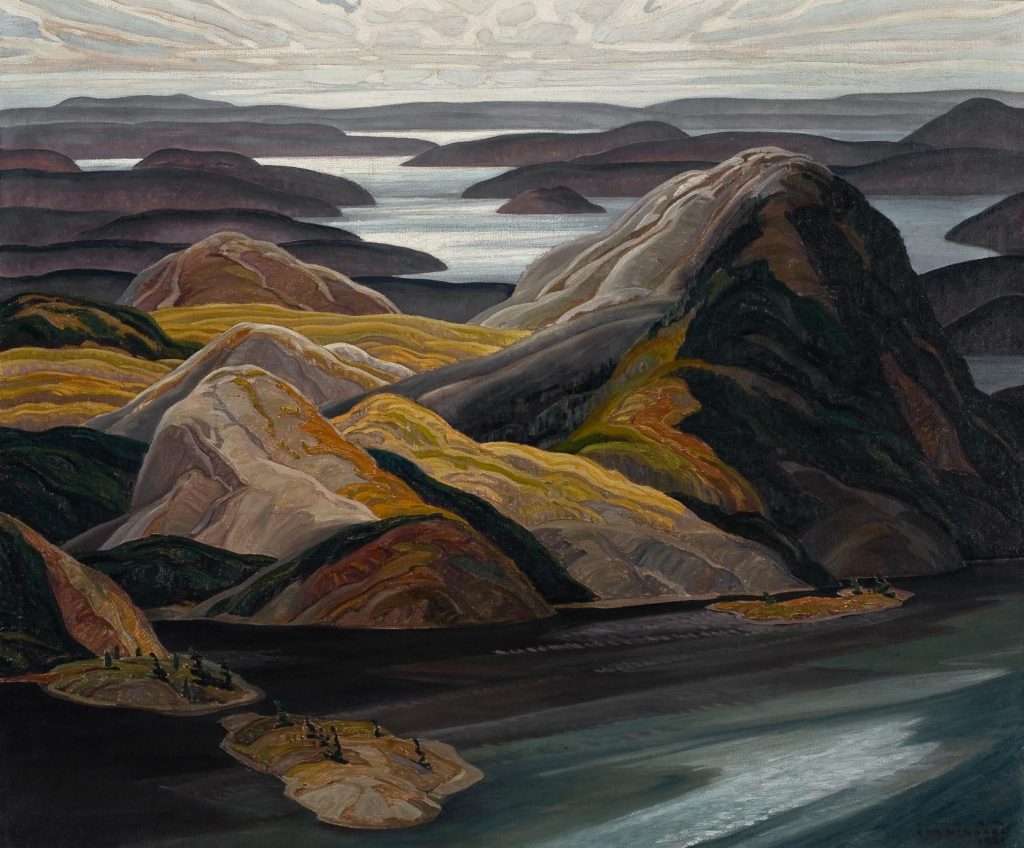
Blue lakes, white hills, pink granite ridges, sugar maples, pine, cedar, oak, black cherry, and American beech fill the La Cloche mountains in Killarney Provincial Park on Georgian Bay in Ontario. This region is situated within the southern area of the Canadian Shield, which itself extends across much of western and northern Ontario. A patchwork of terrains and topographies define this coastal landscape.
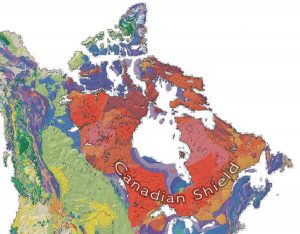
Franklin Carmichael made his first trip to the La Cloche area of Killarney with several members of the Group of Seven in 1925. Members of the Group had first visited the Algoma region north of Lakes Superior and Huron in 1918 when they stopped off in the city of Sault Ste. Marie and later travelled by rail along the coastline. Later, in 1935, Carmichael constructed a cottage on the shores of Cranberry Lake, nestled in among the La Cloche mountains and the many other lakes, including Grace Lake, that inspired him.
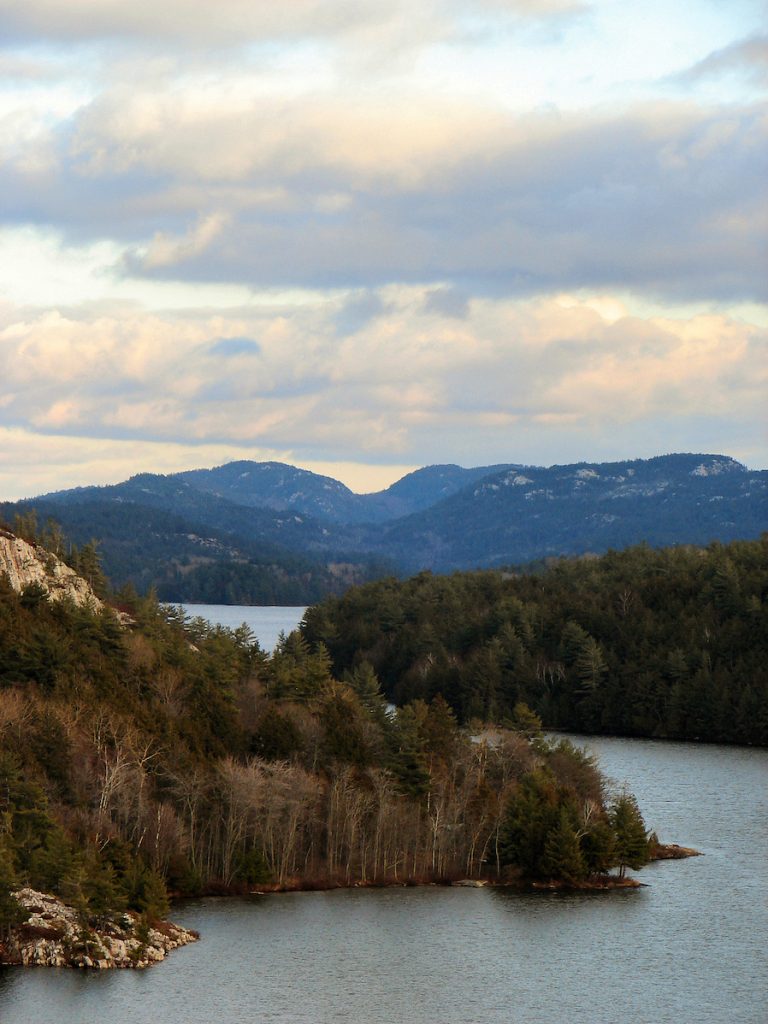
Taking a cue from current ecological and climate crises, we might begin to think art historically about the geological and environmental history of the Killarney region, in contrast to the preoccupation with wilderness and national symbols that have characterized Group of Seven scholarship.[1] Seen as breaking with European artistic traditions, the Group of Seven’s paintings of the Canadian landscape were equated with social, cultural, and political meanings and ideals.
One legacy of the Group was founded not on the effects of modernization but rather the notion that their work represented Canada as quintessential empty and imposing wilderness. Joan Murray describes the bedrock of the Canadian Shield as “the fundamental basis of Canada.”[2] With this in mind, I employ in the following essay an ecocritical approach that mobilizes multiple practices, including visual analysis, cultural interpretation, environmental history, and climate change discussions.
A landscape of lakes
Although situated relatively inland from the archipelago of islands that are scattered along the north shore of Lake Huron, Carmichael’s Grace Lake suggests the vast proliferation of lakes in and around the La Cloche mountains. The wider view of Grace Lake has been reimagined to suggest further lakes visible over the hills. Grace Lake itself is a gradient from almost pitch black to a metallic blue, concealing the point where it joins the lakes beyond. The same metallic finish continues throughout the receding composition, contrasting with the patchwork of quartzite and granite. Where considerable attention has been paid to the foreground and the stylized sky above, the imagined landscape beyond has been left comparatively plain and unadorned.
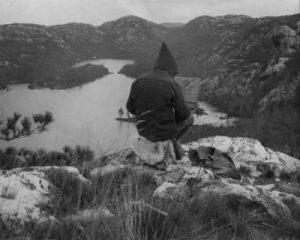
Having first apprenticed at Grip Limited in 1911, a commercial art firm in Toronto, alongside others from the Group of Seven, in 1932 Carmichael left his job as a commercial artist to become the Head of the Graphic Design and Commercial Art Department at the Ontario College of Art. Graphic qualities are visible in his paintings, where an emphasis on pattern, delineation of form, and design emerge from his interpretation of the natural environment. The mountains are constructed as bulbous shapes rising from the reflective pools of water that are Grace Lake and the many surrounding bodies of water. The same curvilinear forms are mirrored in the clouds above, which billow across the sky.
In 1935, the artist and friend of the Group of Seven, Joachim Gauthier, took a photo of Carmichael, sat upon an exposed white quartzite rock while looking down on Grace Lake. The hooded figure of Carmichael is at work on a small sketch, propped on a board within his paint box. This same vantage point reappears throughout his work. Surrounded by the La Cloche mountains, Grace Lake is a relatively small feature on the landscape, being only two kilometers long and a few hundred feet wide. Yet Carmichael’s painting has expanded upon it to accommodate the extent of Killarney’s many lakes.
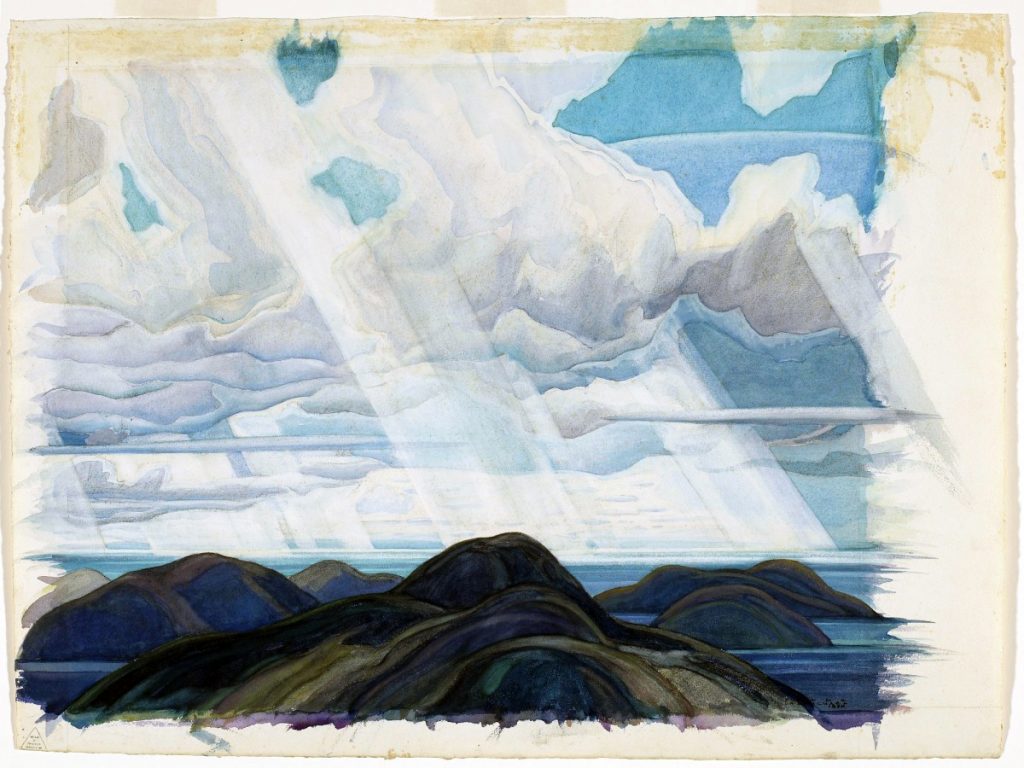
Gradients of geological color
Uniquely among members of the Group of Seven, Carmichael worked primarily with watercolor and in 1925 co-founded the Ontario Society for Painters in Watercolour. Grace Lake is, however, an exception. Here, the effects of watercolor are manifested in oil paint. While Carmichael believed that watercolor offered the best expression of the Canadian light and landscape, in lecture notes he wrote, “It is influential that the artists reveal through the medium in which he is happiest, what he sees, thinks, and feels about his surroundings.”[3] The monumentality of Grace Lake is communicated through sinuous ribbons of oil paint, preserving the same qualities of light that Carmichael usually sought in watercolor.
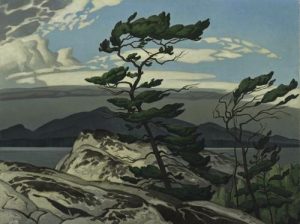
Formed nearly two billion years ago, the eroded ridges of the white quartzite hills of the La Cloche mountains were shaped by four different glaciers and then 11,000 years of wind and weather. Marked by higher elevations, sharp ridges, and terraced forests, the Killarney landscape is relatively inaccessible, and its distinct geological formations are thought to have once reached higher than today’s Canadian Rocky Mountains. They do, however, remain among the highest peaks in Ontario. Among these white quartzite hills is the Dreamer’s Rock, a sacred site for the Ojibwe, and the location of The White Pine, painted by Group member A.J. Casson.
We should pause here to recognize the erasure of Indigenous sites and peoples from the visual history of the Canadian landscape more broadly. Such recognition is critical to de-colonizing the Group’s work.[4] We must confront the legacies of colonialism, and centre Indigenous perspectives that challenge constructed national identities that actively erase First Nations, Métis, and Inuit histories and communities. Carmichael’s Grace Lake sits on the traditional lands of the Ojibwe, Odawa, and Potawatomi Peoples, yet any historic or contemporary human presence has been consciously removed. The Group of Seven’s landscape paintings have instead been constructed around the idea of emptiness.
Throughout his visits to Algoma and Killarney, Carmichael’s paintings reflected the light and color that bounced off the white quartzite hills and surrounding lakes. The artist and writer, Erika Alin notes the intricacies of the Canadian Shield, where “patches of pink, red, and black minerals [. . .] form endless interesting streaks and patterns, and delicate light pink lines extend like interlocking webs across the smooth black surfaces of scattered boulders.”[5] The composition of Grace Lake is set into the granite and syenite of the Shield, painted in shades of grey, brown, yellow, and orange. Interspersed among the cliffs and rocky foreground, where a great abundance of metamorphic rock composes this never-ending coastal precipice, are patches of lichen, moss, and other vegetation.
Unlike Grace Lake in the foreground, the bodies of water beyond are bleached a silvery blue, removing any suggestion of weather from the water’s surface. The clear blue of the water might also indicate ecological damage, notably acidification, caused by industrial mining, a prevalent industry in the region during the early twentieth century. Neighboring Nellie Lake, for example, known for its crystal-blue color, is so severely acidified that it can no longer sustain life.[6] The realities of environmental and settler colonial history, and the geomorphology of the Canadian Shield are revealed through Carmichael’s varying application of color and his interest in form and shape. His use of colour and form in turn suggests Carmichael’s own awareness of Ontario’s distinct geology and ecology, with his work allowing him to explore the region’s natural history and the human-induced impact of the timber and mining industries prevalent here since the nineteenth century.
From wilderness to industrialized landscape
The Ontario wilderness that the Group of Seven sought to represent had already been shaped by growing infrastructure—notably the construction of the railway—and the development and growth of towns and cities, including Thunder Bay and Sault Ste. Marie, along the northern shores of Lakes Huron and Superior. It no longer exemplified an understanding of wilderness as a barren and desolate space, far removed from civilization. Rather, the processes of modernization facilitated the Group’s travels around Canada. There are few instances that signal the Group’s awareness of environmental damage and destruction. However, the continued threat of logging on the landscape led to Carmichael and his colleague Alexander Young (A.Y.) Jackson lobbying Ontario’s provincial government to establish Killarney as a protected area. Finally, in 1964 Killarney acquired the status of a provincial park.

In the 1930s, Carmichael explored the theme of Ontario’s industrial landscape. From the geological focus in Carmichael’s Grace Lake, we might subsequently turn our attention to scenes of the Algoma mining industry found in the work of Jackson, Carmichael, and Yvonne McKague Housser (wife of the art critic and friend of the Group Fred Housser).[7] The extractive processes of industrialization radically altered the geography and ecology of Ontario’s landscape. During the mid-twentieth century, nickel mining and smelting damaged many of Killarney’s lakes, including Nellie Lake and Cranberry Lake, which were repeatedly painted by Carmichael. The idea of a pristine wilderness stands to be challenged further, beyond recent scholarship, as it continues to disregard the environmental realities of Indigenous history, colonization, tourism, and industrialization.
Through Carmichael’s Grace Lake, and others like it, these landscapes manifest as something other than representations of Canadian northernness and national identity. The emphasis on the use of light and color reveals the geology of the environment and the resulting ecological devastation caused by the natural resource industry. It moves away from a prevailing interest in nationalism, symbolism, and the wilderness. Such an ecocritical reading might be extended to depictions of wider Canada by the Group of Seven, and as such recontextualizes these paintings in line with environmental history at a time of unprecedented anthropogenic climate change.
About the author
Isabelle Gapp is an Arts & Science Postdoctoral Fellow at the University of Toronto. She holds a PhD in History of Art from the University of York (2020). Her research considers the intersections between nineteenth- and twentieth-century landscape painting, gender, environmental history, and climate change around the Circumpolar North. Isabelle is the co-lead, alongside Professor Mark A. Cheetham, of the JHI Working Group Visual Cultures of the Circumpolar North (2021-2022) and serves as an editor for the Network in Canadian History & Environment (NiCHE). She is currently working on her first book, A Circumpolar Landscape: Art and Environment in Scandinavia and North America, 1890-1930, to be published by Lund Humphries as part of their Northern Lights series (forthcoming 2023).
Further reading
Alin, Erika. Lake Effect: Along Superior’s Shores. Minneapolis: University of Minnesota Press, 2003.
Gapp, Isabelle. “Water in the Wilderness: The Group of Seven and the Coastal Identity of Lake Superior.” Journal of Canadian Studies/Revue d’études canadiennes 55, no. 3 (2021): 590-620.
Kelowna Art. “Northern Pine Lecture Series with Siobhan Angus.” YouTube video, 01:04:15, January 22, 2021.
McKowen, Nicole Mari. “Transcendental Nature and Canadian National Identity: Franklin Carmichael’s Representation of the Canadian Landscape.” Master’s dissertation, Texas Christian University, 2019.
Murray, Joan. “Carmichael’s Triumph?” Journal of Canadian Studies/Revue d’études canadiennes 25, no. 2 (1990): 155–59.
Murray, Joan. Rocks: Franklin Carmichael, Arthur Lismer, and the Group of Seven. Toronto: McArthur & Company.
O’Brian, John, and Peter White, eds. Beyond Wilderness: The Group of Seven, Canadian Identity, and Contemporary Art. Montreal: McGill-Queen’s University Press, 2007.
Shead, Justin A. “Chemical and Biological Recovery of Killarney Park, Ontario Lakes (1972-2005) from Historical Acidification.” Master’s dissertation, Queen’s University (Canada), 2007.
Weinhart, Martina, and Georgiana Uhlaryik, eds. Magnetic North: Imagining Canada in Painting, 1910–1940. Munich: Prestel Verlag, 2021.
- The institution of the National Gallery of Canada also played an instrumental part in bolstering support for the Group of Seven. From 1913 onwards, prior to their formation as a Group in 1920, the NGC, initially under the direction of Eric Brown, regularly bought their paintings and later incorporated them into international exhibitions on Canadian art. This affixed both the group and the landscape they painted as national symbols. ↵
- Joan Murray, Rocks: Franklin Carmichael, Arthur Lismer, and the Group of Seven (Toronto: McArthur & Company, 2006), 25. ↵
- Franklin Carmichael qtd. in Nicole Mari McKowen, “Transcendental Nature and Canadian National Identity: Franklin Carmichael’s Representation of the Canadian Landscape” (Master's dissertation, Texas Christian University, 2019). ↵
- See John O’Brian and Peter White, eds., Beyond Wilderness: The Group of Seven, Canadian Identity, and Contemporary Art (Montreal: McGill-Queen’s University Press, 2007). ↵
- Erika Alin, Lake Effect: Along Superior’s Shores (Minneapolis: University of Minnesota Press, 2003), 70. ↵
- Justin A. Shead, “Chemical and Biological Recovery of Killarney Park, Ontario Lakes (1972-2005) from Historical Acidification” (Master's dissertation, Queen’s University, 2007). ↵
- Kelowna Art, “Northern Pine Lecture Series with Siobhan Angus,” YouTube video, 01:04:15, January 22, 2021. ↵
The Canadian Shield is a large area of exposed Precambrian igneous and high-grade metamorphic rock that forms the ancient geologic core of the North American continent.
The Group of Seven was a group of Canadian landscape painters, active in the 1920s and 1930s.
A form of colonization that seeks to remove Indigenous populations from their traditional lands and replace them with a new society of settlers.
Geomorphology is the study of landforms, their processes, form, and sediments at the surface of the Earth (and sometimes on other planets).
Anthropogenic means environmental change caused or influenced by humans, either directly or indirectly.

